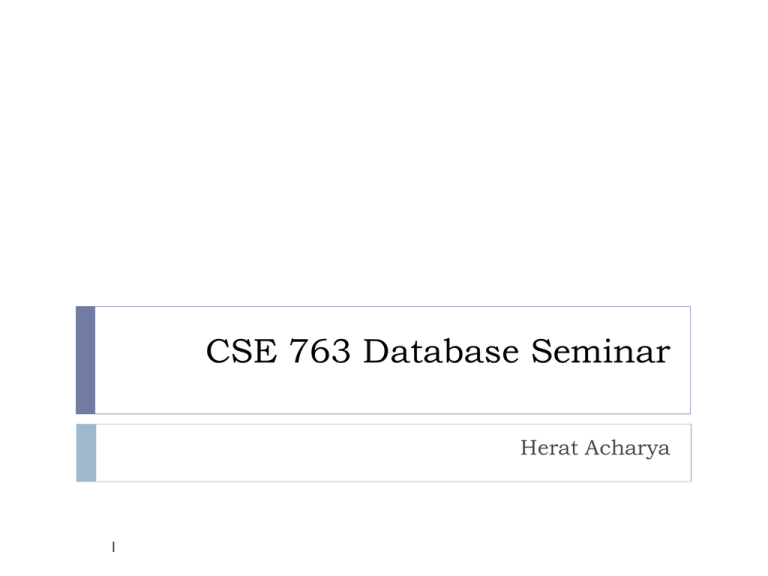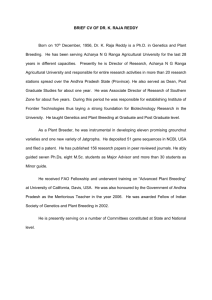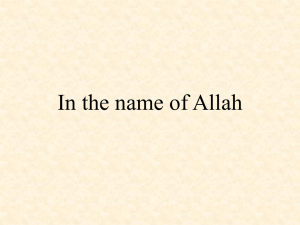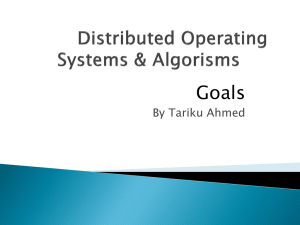CSE 763 Database Seminar Herat Acharya 1
advertisement

CSE 763 Database Seminar
Herat Acharya
1
Towards Large Scale Integration: Building a
MetaQuerier over Databases on the Web.
- Kevin Chen-Chuan Chang, Bin He and Zheng
Zhang. (UIUC)
Few Slides and pictures are taken from the author’s presentations on this paper.
2
Presented by Herat Acharya
Introduction
Deep Web:
“The deep Web (also called Deepnet, the invisible Web, dark Web or the hidden Web)
refers to World Wide Web content that is not part of the surface Web, which is
indexed by standard search engines.” – Wikipedia
Since the structure data is hidden behind web forms, its inaccessible to search engine crawlers.
For eg: Airline Tickets and Books website.
Finding sources:
Wants to upgrade her car– Where can she study for her options? (cars.com,
edmunds.com)
Wants to buy a house – Where can she look for houses in her town? (realtor.com)
Wants to write a grant proposal. (NSF Award Search)
Wants to check for patents. (uspto.gov)
Querying sources:
3
Then, she needs to learn the grueling details of querying
Presented by Herat Acharya
Introduction – Deep Web
Cars.com
Apartments.com
411localte.com
4
Amazon.com
Biography.com
401carfinder.com
Presented by Herat Acharya
Goals and Challenges
Goals:
To make the Deep Web systematically accessible. This will help the users to find
online databases useful for their queries.
To make the Deep Web uniformly usable. That is to make it user friendly so that the
user can query databases with no or least prior knowledge of the system.
Challenges:
5
The deep Web is a large collection of queryable databases and it is only increasing.
Requires the integration to be dynamic. Since the sources are proliferating and
evolving on the web, this cannot be statistically configured.
The system is ad-hoc as the most of the time the user knows what is he searching
for in structured databases.
Since the system is ad-hoc it must do on the fly integration.
Presented by Herat Acharya
System architecture
MetaQuerier
Front-end: Query Execution
Type Patterns
Result
Compilation
Query
Translation
Source
Selection
Query Web databasesFind Web databases
Deep Web Repository
Query Interfaces
The Deep
Web
Query Capabilities Subject Domains
Unified Interfaces
Back-end: Semantics Discovery
Grammar
Database
Crawler
6
Interface
Extraction
Source
Clustering
Schema
Matching
Presented by Herat Acharya
Demo
7
Presented by Herat Acharya
System architecture
Backend:
Automatically collects Deep Web sources from the crawler.
Mines sources semantics from the collected sources.
Extracts query capabilities from interfaces.
Groups (or clusters) interfaces into subject domains.
Discovers semantic (schema) matching.
Deep Web Repository:
The collected query interfaces and discovered semantics form the Deep Web
Repository.
Exploited by the frontend to interact with the users.
Constructed on the fly.
Frontend:
8
Used to interact with the users.
It has a hierarchy based on domain category which is automatically formed by
source clustering in the backend.
User can choose the domain and query in that particular domain.
Presented by Herat Acharya
Subsystems
Database Crawler (DC):
9
Functionality:
Automatically discovers Deep Web databases, by crawling the web and identifying
query interfaces.
Query interfaces are passed to interface extraction for source query capabilities.
Insight:
Building a focused crawler.
Survey shows that the web form(or query interface) is typically close to the root (or
home page) of the Web site, which is called depth.
Statistics of 1,000,000 randomly generated IPs show that very few have depth more
than 5 and 94% have depth of 3.
Approach:
Consists of 2 stages: Site collector and shallow crawler.
Site collector finds valid root pages or IPs that have Web Servers.There are large no.
addresses and a fraction of them have Web servers. Crawling all addresses is inefficient.
Shallow crawler crawls the web server from the given root page. It has to crawl only
starting few pages from the root page according to the statistics above.
Presented by Herat Acharya
Subsystems
Interface Extraction (IE):
Functionality:
Insight:
Common query interface pattern in a particular domain.
Hence there exists a hidden syntax across holistic sources (Hypothesis).
Therefore this hypothesis transforms an interface into a visual language with a nonprescribed grammar. Hence it finally becomes a parsing problem.
Approach:
10
The IE subsystem extracts the query interface from the HTML format of the Web
page.
Defines a set of constraint templates in the form of [attribute;operator;value] . IE
extracts such contraints from a query interface.
For eg: S1 :[title;contains;$v] , S2 :[price range;between;$low,$high]
The HTML format is tokenized by the IE, these tokens are parsed and then merged
into muiltiple parsed tress. This consists of a 2P grammar and best effort parser.
Human first examines varied interfaces and creates a 2P grammar.These consists of
productions which capture hidden patterns in the forms.
Patterns might conflict thus its conventional precedence or priorities are also captured
called as preferences.
Presented by Herat Acharya
Subsystems
11
Approach: (contd.)
The hypothetical syntax is dealt by the best effort parser.
It prunes ambiguities by applying preferences from the 2P grammar and recognizes the
structure and maximizes results by applying productions.
Since it merges multiple parse trees an error handling mechanism is also employed(to
be seen in the later slides).
Merger parses all the parse trees to enhance the recall of the extraction.
Presented by Herat Acharya
Subsystems
Schema Matching (SM):
12
Functionality:
Extracts semantic matching among attributes from the extracted queries.
Complex matching is also considered. For eg: m attributes are matched with n
attributes thus forming an m:n matching pattern.
Discovered matching are stored in Deep Web Repository to provide a unified user
interface for each domain.
Insight:
Proposes an holistic schema matching that matches many schemas at same time.
Current implementation explores co-occurrence patterns of attributes for complex
matching.
Approach:
A two step approach: data preparation and correlation mining.
The data extraction step cleans the extracted queries to be mined.
Correlation mining discovers correlation of attributes for complex matching schemas.
Presented by Herat Acharya
Subsystems
Example of Schema Matching
13
Presented by Herat Acharya
Putting Together: Integrating Subsystems
With just the single system integration, errors persist.
Different interpretations of the same token may lead to conflicts. For eg:
after a name field there is a label field with Mike.This is conflicting with the
system as to what should it consider name or Mike.
To increase the accuracy of the subsystems, authors propose 2 methods
Ensemble cascading:
To sustain the accuracy of SM under imperfect input from IE.
Basically cascades many SM subsystems to achieve robustness.
Domain feedback:
To take advantage of the information in latter subsystems.
This improves accuracy of IE.
Uses domain statistics from schema matching to improve accuracy.
Cascade
Si
Sj
Sk
Feedback
14
Presented by Herat Acharya
Putting Together: Integrating Subsystems
Ensemble Cascading:
With just a single SM subsystem connected with IE, performance degrades with
noisy input.
Hence we don’t need all input schemas for matching .
Voting and sampling techniques are used to solve the problem.
First sampling is done and a subset of input schemas are chosen.
There are abundant schemas, hence its likely to contain correct schemas.
Sampling away some schemas many reduce noise as the set is small.
Multiple sampling is taken and given to rank aggression.
Rank aggression combines all schemas and does a majority voting
Majority voting involves selecting those inputs which frequently occur.
Foreg: author, title, subject, ISBN in a book site.
15
Presented by Herat Acharya
Putting Together: Integrating Subsystems
16
Presented by Herat Acharya
Putting Together: Integrating Subsystems
Domain Feedback:
In Fig a:
C1 = [adults,equal,$val:{1,2,..}] and C2 = [adults,equal,$val:{round-trip,oneway}]
They conflict because there system.
But by observing the distinctive patterns in other interfaces, it concludes adults is a numeric
type.
17
Large amount of information to resolve conflicts are available from peer query interfaces
in the same domain.
Presented by Herat Acharya
Putting Together: Integrating Subsystems
Domain Feedback:
Three domain statistics have been observed to effectively solve conflicts:
Type of attributes:
Collects common type of attributes. For eg: when matching 2 schemas of
Books domain Title is a common attribute.
Frequency of attributes:
Frequency of the attributes occurring in the schema is taken into
consideration. For eg: In airlines domain departure city, departure date,
passengers, adults, children are frequently occurring attributes.
Correlation of attributes:
Takes correlation of attributes within the group, i.e. attributes within the
group are positively correlated and attribute across groups are negatively
correlated.
18
Presented by Herat Acharya
Unified Insight: Holistic Integration
How it is done in MetaQuerier?
Its all about sematics discovery.
Take a holistic view to account for many sources together in integration
Globally exploit clues across all sources for resolving the ``semantics'' of
interest
A conceptually unifying framework.
Proposed ways of Holistic Integration:
19
Hidden Regularities
Peer Majority
Presented by Herat Acharya
Unified Insight: Holistic Integration
Hidden Regularities:
Deals with finding hidden information that helps in sematics discovery.
For eg: For IE its hidden syntax and for SM its hidden schema.
Shallow observable clues: ``underlying'' semantics often relates to the ``observable''
presentations in some way of connection.
Holistic hidden regularities: Such connections often follow some implicit properties, which
will reveal holistically across sources.
Reverse analysis has to be done which holistically analyzes shallow clues as guided by hidden
regularities.
Some Way of Connection
Presentations
(observed)
Hidden
Regularities
Semantics:
(to be discovered)
Reverse Analysis
20
Presented by Herat Acharya
Unified Insight: Holistic Integration
Hidden Regularities (cont)
Evidence 1: [SIGMOD04]
Query Interface Understanding
by Hidden-syntax parsing
Evidence 2: [SIGMOD03, KDD04]
Query Interfaces Matching
by Hidden-model discovery
Syntactic
Composer
Visual
Patterns
Hidden
Syntax
(Grammar)
Visual Language
Parser
21
Statistic
Generator
Query
Capabilities
Attribute
Occurrences
Hidden
Generative
Model
Attribute
Matchings
Corelation
Mining
Presented by Herat Acharya
Unified Insight: Holistic Integration
Hidden Regularities (cont)
Evidence 1: [SIGMOD04]
Query Interface Understanding (IE)
Hidden-syntax parsing
attribute
22
operator
Evidence 2: [SIGMOD03, KDD04]
Matching Query Interfaces (SM)
Hidden-model discovery
value
Presented by Herat Acharya
Unified Insight: Holistic Integration
Peer Majority (Error Correction):
Basically deals with gathering information from peers or neighboring subsystems for
error correction.
This is based on following hypothesis:
Reasonable base: The base algorithm is reasonable. Its not perfect but errors are rare.
Random samples: Base algorithm can be executed over randomly generated samples.
Foreg:
Ensemble Cascading:
SM enhances accuracy for matching query schemas. SM creates multiple samples of schemas by
“downsampling” the original input, hence we create random samples and we assume that the
algorithm for SM produces correct output.Thus we do majority voting which increases the accuracy
of the system
Domain Feedback:
This feature increases the accuracy of IE subsystem. The crawler is run for every interfaces, thereby
creating multiple samples and we assume the base algorithm is reasonable. Feedback mechanism
gathers statistics from all samples indicating majority.
23
Presented by Herat Acharya
Conclusions
Problems in accessing structured databases on
the Web.
System architecture of MetaQuerier.
How the systems are integrated holistically.
What have we learnt while integrating the
subsystems?
24
Presented by Herat Acharya
Entity Rank: Searching Entities Directly and
Holistically
- Tao Cheng, Xifeng Yan, Kevin Chen-Chuan Chang.
(UIUC)
Few Slides and pictures are taken from the author’s presentations on this paper.
25
Presented by Herat Acharya
Entity Search - Introduction
Focuses on data as an “Entity” rather than data as a document.
Consider few scenarios:
Scenario 1: Amy want to find customer service “phone number” of
Amazon.com. How does she go about finding it on the Web? Finding an
entity such as a phone no. can be time consuming on the Web as Amy has to
browse several pages to find one.
Scenario 2: Amy wants to apply for graduate schools. How can she find
“professors” in “database” area of a particular school. Likewise she has to go
through various departmental web pages to find what she wants.
Scenario 3: Amy wants to prepare for a seminar. How can she find a “pdf” of
a “ppt” of a “research paper”?
Scenario 4: Now Amy wants to read a book. How can she find the exact
“prices” and “cover images” of the books she likes to read without minimal
effort?
The problem of finding exactly what we want is addressed in
the Entity Search.
26
Presented by Herat Acharya
Traditional Search Vs Entity Search
Traditional Search
Entity Search
Results
Results
Keywords
27
Support
Entities
Presented by Herat Acharya
How does Entity Search work?
As input, users describe what they are looking for.
User can specify entity and keywords.
To distinguish between entity and keywords user use “#”.
For eg:
Query Q1: ow(amazon customer service #phone)
Query Q2: (#professor #university #research=“database”)
Query Q3: ow(sigmod 2006 #pdf_file #ppt_file)
Query Q4: (#title=“hamlet” #image #price)
Context pattern: A target entity matches any instance of
that entity type.
Content restriction: How will results appear?
28
Presented by Herat Acharya
How does Entity Search work?
As an output they will directly get what they want.
Entities are matched holistically and are ordered according to their scores.
29
Presented by Herat Acharya
The Problem: Entity Search
Not like finding documents on the Web. The system must be made “entityaware”.
We consider E = {E1,E2,….En} as a set of entities over a document
collection D = {D1,D2,…..Dn}
Since entity search is a contextual search it lets the user specify patterns
(α) , i.e. how they may appear in certain pattern in collection D.
The output is ranked as m-ary entity tuples in the form of t = {e1,e2,….,en}.
The measure of how t matches the query q is denoted by a query score as:
Score(q(t)) = Score(α(e1,e2,….em,k1,k2,……kl))
Where q(t) is the measure of how t appears according to the tuple pattern
α across various documents
30
Presented by Herat Acharya
Characteristic I – Contextual
Appearance of keywords and entity instances might be different. There are 2 factors
– Pattern and Proximity
Context
Content
31
Presented by Herat Acharya
Characteristic II – Uncertainty
Entity extraction is always not perfect and its extraction confidence probability must
be captured.
32
Presented by Herat Acharya
Characteristic III – Holistic
A specific entity may occur multiple times in many pages. Every instance of the
entity must be aggregated.
33
Presented by Herat Acharya
Characteristic IV – Discriminative
Entity instances matched on more popular pages should be ranked higher than
instances matched on lesser popular pages.
34
Presented by Herat Acharya
Characteristic V – Associative
35
An entity instance must not be accidental.
Hence we must carefully calibrate to purify the
associations we get.
Presented by Herat Acharya
The Impression Model - Theoretically
Assuming:
No time constraints
Unlimited resources
For query Q1 = (“amazon customer service”, #phone),
collection over Web say D.
36
Dispatch an observer to repeatedly access Web D.
Collects all evidence for potential answer.
Examines the document d for any instance of #phone near the keyword.
Forms a judgment of how good the matches are and due to unlimited
memory he remembers every judgment.
Stops when he gets sufficient evidences and calculates the score.
Presented by Herat Acharya
The Impression Model - Theoretically
Access layer: For accessing each document .
Recognition layer: While searching the document, it recognizes any tuple
present.
Association Probability: Signifies the relevance of the tuple.
At some time
the observer may have sufficient trials. At that point
his impression stabilizes.
The Access probability is p(d) ie probability that observer visits a document
d.
Hence over T trials d will appear T x p(d) times
Thus if T is sufficiently large association probability of q(t) over entire
collection D will be :
37
Presented by Herat Acharya
The Impression Model – The naïve observer
Treats all documents uniformly.
Access layer: Views each document equally with uniform probability ie
(where |D| = n)
Recognition layer: The observer accesses p(q(t)|d) by document cooccurrence for all entity and keywords specified in q(t) ie p(q(t)|d) = 1 if
they occur 0 otherwise.
Overall Score Thus the overall score is given by:
Limitations :
38
Does not discriminate sources.
Not aware of entity uncertainty and contextual patterns
A validation layer is lacking.
Presented by Herat Acharya
Entity Rank - Concretely
A new virtual observer is introduced who will perform
the observation job over a randomized version of D say
D’ .
A validation layer to compares the impression of real
observer with that of virtual observer.
Defines 3 layers:
39
Access layer (Global Aggregation)
Recognition layer (Local Assessment)
Validation Layer (Hypothesis Testing)
Presented by Herat Acharya
Entity Rank - Concretely
40
Presented by Herat Acharya
Access Layer – Global Aggregation
Defines how the observer selects the documents.
Discriminates the documents searched by their “quality”.
Measure of quality depends on document collection ie its
structure – for web documents the notion of popularity
metric is chosen.
Random walk model: It defines p(d), which is the probability of
visiting a document d.
It used PageRank method to find out the popularity metric ie
p(d) = PR[d].
41
Presented by Herat Acharya
Recognition Layer – Local Assessment
Defines how observer examines a document d locally for a tuple.
This layer determines p(q(t)|d) ie how query tuple q(t) in the form of
α(e1,e2,….em,k1,….kl) holds true given d.
Each entity or a keyword may appear many times. They combine all the
instance as described : γ(o1,o2,…..on).
Hence ,
Where
Next, to define context operator
matching α in terms of context.
Its done in 2 steps:
42
ie how γ occurs in a way
Boolean pattern analysis
Probabilistic proximity analysis.
Presented by Herat Acharya
Recognition Layer – Local Assessment
Boolean pattern analysis:
Its defined as αB which returns 1 or 0 whether some pattern is satisfied
or not.
For eg: doc(o1,o2,…..om) objects must occur in the same document.
Probabilistic proximity analysis:
Defines αP , how well the proximity between objects match the desired
tuple.
The closer they appear to each other the more relevant they are as a
tuple (span proximity model).
(by applying Bayes’ Theorem)
43
Presented by Herat Acharya
Validation Layer – Hypothesis Testing
Validates the significance of the impression.
Suggested null hypothesis to validate thereby simulating a virtual observer.
Create a randomize version of D say D’.
First we randomly search entities and keywords in D’ with same probability
of appearing in any document of D.
Thus probability of entity/keyword belonging to d’ is:
Probability that a tuple belonging to entire collection D’ is
is the probability of t appearing in some document d’. Its
defined by:
44
Presented by Herat Acharya
Validation Layer – Hypothesis Testing
Next we define a probability of tuple t in d’
The contextual probability is defined by :
Putting all these equations together we get pr
Now we should compare pr with po . Using G-Test we compare these 2
values. The score is given by
Higher the G-Test score the more likely that entity instances t appear with
keyword k. Here po, pr<< 1.
45
Presented by Herat Acharya
Entity Rank – Scoring Function
Validation
46
Global Aggregation
Local Recognition
Presented by Herat Acharya
Entity Rank – Algorithm
47
Presented by Herat Acharya
Experimental Setup
Corpus: General crawl of the Web(Aug, 2006),
around 2TB with 93M pages.
Entities: Phone (8.8M distinctive instances)
Email (4.6M distinctive instances)
System: A cluster of 34 machines
48
Presented by Herat Acharya
Comparing Entity Rank with Various
Approaches
Contextual Uncertain
Holistic
Discriminative Associative
Naïve
Local
Global
Combine
Without
EntityRank
49
Presented by Herat Acharya
Example Query Results
50
Presented by Herat Acharya
Comparison – Query Results
%Satisfied Queries at #Rank
Query Type I:
Phone for Top-30 Fortune500 Companies
51
EntityRank
Naïve approch
Local only
Global only
Combine L by simple summation
L+G without hypothesis testing
Query Type II:
Email for 51 of 88 SIGMOD07 PC
Presented by Herat Acharya
Conclusions
Formulate the entity search problem
Study and define the characteristics of entity
search
Conceptual Impression Model and concrete
EntityRank framework for ranking entities
An online prototype with real Web corpus
52
Presented by Herat Acharya
Questions???
53
Presented by Herat Acharya
Thank You!!!!
54
Presented by Herat Acharya





